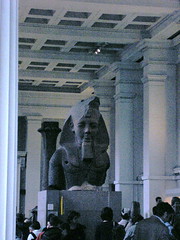We had some interesting cultural experiences - vile phrase! - during our London stay. Two places I'd never visited were the British Library and the British Museum, which between then provided us with warm venues when the weather turned decidedly chilly.
At the Library we visited the Sacred exhibition, subtitled "discover what we share": a collection of sacred texts from Christianity, Islam and Judaism, including a fragment of a Dead Sea Scroll and the earliest complete New Testament, the Codex Sinaiticus. I was fascinated by the 4th century manuscript containing long quotations from a Syrian version of the Diatessaron, a compendium of the four Gospels originally composed in the second century and later suppressed by the church, as I was by actually seeing the Lindisfarne Gospels. There were fantastically decorated copies of the Qur'an and the Torah, but in such a wealth of material it was impossible to absorb everything and we found ourselves focussing on the Christian exhibits - the earliest of which contained no decoration at all and seemed to embody the urgency with which the early church sought to preserve the continuity of belief and understanding as the first-hand witnesses died out.
The afternoon in the British Museum lasted for just enough time to be intimidated by the immense Egyptian and Assyrian statues (see pic) and aroused by the sight of what is now called the Parthenon Frieze. I know the history of how the Parthenon was used to store gunpowder and could well have ended up as a pile of dust, but I can't help feeling that now the "Elgin marbles" should be returned to Greece. London is probably more of a target for today's violence than Athens is, and though it's interesting to see the real thing close up, it would be more powerful to see them in situ. Actually, I grew up with these reliefs; they were - and presumably still are - round the ceiling of Hillhead Primary School (Glasgow) stairwell, tastefully outlined in dust.
Lasting impression? The sight of a 3600-year-old Pharoah looking serenely out over the scuttling of tourists and posing effortlessly as part of their photos. What of our efforts, I wonder, will we leave behind?

They've actually constructed a new museum in Athens directly below the Acropolis with a section specifically to house the marbles. It would be great to see them back where they belong, it seems ridiculous to have half the Acropolis treasure in a poorly lit back room of the British Museum. The old argument about the marbles being better preserved in London is no longer relevant.
ReplyDeleteI had a preview of the new museum last week. Its curators have worked out a most bizarre way to embarrass the British into sending the Elgin Marbles bak to Athens. See http://www.timescolumns.typepad.com/stothard/
ReplyDeleteI've just read your post, David. It is a tad bizarre - let's hope people get it.
ReplyDelete